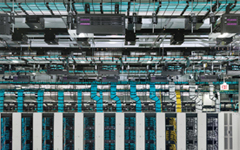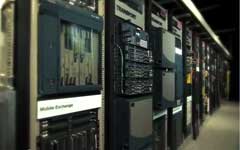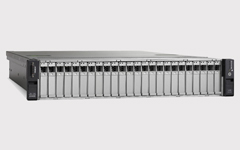Big Data, Big Changes
Achieve big data success with Cisco UCS bundled solutions, reference architectures, and proven expertise.

Big Data
Big Data is the focus of today's enterprises - how to capture, manage and analyze it. Learn what big data means to enterprise IT and how to support it with the Cisco Common Platform Architecture. CPA is based on Cisco Unified Computing, Unified Fabric, and Unified Management.
Cisco has partnered with leading software providers to offer a comprehensive infrastructure and management solution to support our customers' initiatives. Find out how it can meet the big data needs of your organization.
Big Data Applications
Learn the network's role, and how these applications can boost your competitive edge. (PDF - 352 KB)
Read ReportBig Data in the Enterprise
Explore the role and the impact of big data on server and network design. (PDF - 3.65 MB)
Read White PaperCisco Unlocks Value with Big Data
See how Cisco IT unlocks hidden business intelligence with Hadoop on UCS (PDF - 336 KB)
Read Case StudyHuge and growing amounts of information are flooding today's enterprises. This is largely due to the increasing number of people, businesses, and devices connected to the Internet. Thirty-three percent of the world's population now has Internet access, and the number of devices is currently estimated at 15 billion.
This has led to a major focus on big data, and on new methods of capturing, managing, and analyzing this flood of information. Enterprise investments in big data solutions center on software capable of making sense of the data deluge, such as:
- Apache Hadoop framework
- NoSQLdata management systems, or
- Massively Parallel Processing (MPP) database analytics engines
In the big data world, enterprises have turned to Cisco UCS Rack servers, with direct, attached storage, Unified Fabic and Unified Management.
Simplified Integration of Architectures
Big data applications are fed by a wide array of unstructured and semi-structured data sources. That includes the Internet, PCs, smartphones, tablets, machines, social media, multimedia applications, and a variety of other connected devices. Cisco can easily and transparently integrate these new big data architectures into the traditional operational design that customers already have.
Key Cisco Big Data technologies include:
Cisco Unified Computing System (UCS)
Cisco UCS unifies computing, networking, management, virtualization, and storage access into a single integrated architecture. This unique fabric-based infrastructure helps to enable end-to-end server visibility, management, and control in both bare metal and virtual environments. It is an ideal platform for big data applications due to the exceptional performance, capacity, and manageability of the UCS solution.
Integrated Server Management
Cisco UCS Manager is an embedded, policy-based management system that helps IT administrators set a wide range of server configuration policies, from firmware and BIOS settings to network and storage connectivity. Individual servers can be deployed in less time and with fewer steps than in traditional environments. Automation frees staff from tedious, repetitive, time-consuming chores that are often the source of errors that cause downtime. This makes the entire data center more cost effective.
Integrated Network Management
The same network architecture can serve both traditional databases and big data solutions, and can be managed from a central location.
Integrated Data Management
Big data environments are pushing the performance limits of business processing solutions. With Cisco Tidal Enterprise Scheduler, Cisco provides workload automation that facilitates the flow of data between a wide variety of applications like Hadoop, cutting costs, and increasing the value realized from big data.
Cisco and Cloudera Talk Big Data
Watch a discussion on big data and benefits of running Cloudera's solutions on Cisco UCS. (3:20 min)
Watch VideoCisco UCS with Intel Hadoop
Learn about Cisco UCS with the Intel distribution for Apache Hadoop software.
Read ReportCisco UCS and MapR
See how these technologies deliver advanced performance for Hadoop workloads.
Read MoreCisco partners with leading software companies to bring big data solutions to market. The three types of big data analytics solutions that Cisco supports are Hadoop, NoSQL, and MPP databases.
Hadoop
Apache Hadoop is an open-source initiative focused on big data implementations. Hadoop provides the software library needed to store, process, and analyze large amounts of data, both structured and unstructured. Hadoop can be especially appealing because it can scale from a single computer to thousands of servers. It offers high availability in the software, in addition to what is offered from the hardware. Cisco has partnered closely with and has validated solutions with a number of Hadoop distributions, including Cloudera, Intel, MapR, Pivotal HD and HortonWorks
NoSQL
NoSQL is a class of database management system characterized by the fact that it does not adhere to the common relational database management system (RDBMS) model. As the name implies, NoSQL does not use SQL as its query language. NoSQL database systems are designed specifically to manage large volumes of data that do not follow a fixed schema. In addition, NoSQL management systems typically have a distributed, fault-tolerant architecture that stores data across multiple servers. It also scales well horizontally to manage large amounts of data when performance and real-time availability are important.
NoSQL is particularly useful for statistical or real-time analyses of information with a growing volume of elements, such as Twitter posts. Cisco partners offering NoSQL solutions that are supported on Cisco UCS currently include Oracle Database and MarkLogic and DataStax.
Massively Parallel Processing (MPP)
MPP relational databases are increasing in popularity. This is because they can deliver fast query responses, and efficiently compress and provide access to large amounts of detailed data. Cisco currently partners with Greenplum Database from Pivotal Labs and ParAccel from Actian Corporation to offer Cisco UCS solutions for MPP relational databases.
Meet Your Analytics Needs
Learn the benefits of Cisco Common Platform Architecture (CPA) for big data.
Read Solution BriefUnlock Big Value with Big Data on Cisco Unified Computing System
Cisco has played a major role in helping customers manage the Internet revolution and information explosion in the Web 2.0 era with its core switching business. With the introduction of the Cisco Unified Computing System, Cisco can now provide a complete infrastructure solution for big data applications. Cisco UCS helps to reduce complexity, improve agility, and significantly lower total cost of ownership.
To meet a variety of big data platform demands, Cisco offers a comprehensive solution stack. The Cisco Common Platform Architecture (CPA) for big data includes computing, storage, connectivity, and unified management capabilities. Unique to this architecture are transparent, simplified data and management integration with an enterprise application ecosystem.
The CPA is built on a Cisco UCS infrastructure using Cisco UCS 6200 Series Fabric Interconnects, Cisco Nexus 2200 Series Fabric Extenders, and Cisco UCS C-Series Rack Servers. Installed in pairs, the Fabric Interconnects offer redundant, active-active connectivity and embedded management using Cisco UCS Manager. The Cisco CPA supports up to 160 servers in a single switching domain. Scaling beyond 160 servers can be implemented easily by interconnecting multiple UCS domains using Cisco Nexus 6000 or 7000 Series Switches. This allows for scalability of thousands of servers and hundreds of petabytes of storage. It can all be managed from a single pane using Cisco UCS Central within a data center or across globally distributed data centers.
UCS Common Platform Architecture
The Cisco CPA base rack solution is now available through the Cisco SmartPlay program, as shown in the table below. Customers can use this configuration as shown, or as a starting point to build larger clusters.
Get configuration details on Cisco Common Platform Architecture for Big Data.

Advantages of UCS CPA for Big Data:
- High performance and scaling: UCS C240 M3 ideal for big data deployments
- Ease of deployment: Rapid deployment of server using "service profiles"
- Comprehensive manageability: Easy to manage and maintain entire cluster
- Coexistence with enterprise applications: Transparent, simplified management and data integration
- Enterprise-class service and support: Leading industry support from Cisco and its partners
Big Data's Role in Network Design
Learn about design considerations for the enterprise network.
Read ReportNetwork Architecture Tips
Get tips on best practices for Validated Network Architecture.
Watch VideoIn-Depth View of Hadoop
Understand Hadoop considerations for the data center in detail.
See PresentationEnterprise Hadoop Guidance
Review the Validated Network Reference Architecture for Hadoop in the enterprise.
See PresentationThe requirements of traditional enterprise data models for application, database, and storage resources have grown over the years. As a result, the cost and complexity of these models has increased, prompting changes in the way big data is stored, analyzed, and accessed.
The new models are based on a scaled-out, shared-nothing architecture. This brings new challenges to enterprises, which need to decide what technologies to use and how. The traditional model is being expanded to incorporate new building blocks. They address the challenges of big data with new information processing frameworks purpose-built to meet big data's requirements.
An enormous amount of data is generated as a result of democratization and ecosystem factors, such as:
- Mobility trends: Mobile devices, mobile events and sharing, and sensory integration
- Data access and consumption: Internet, interconnected systems, social networking, and convergent interfaces and access models
- Ecosystem capabilities: Major changes in the information processing model and the availability of an open source framework
Network Fabric Requirements and Big Data
A fundamental enterprise requirement is the ability of big data components to integrate alongside current business models. This integration of new, dedicated big data models can be completed transparently while using Cisco Nexus network infrastructures optimized for big data.
Dramatically Reduce Latency (PDF - 479 KB) ![]()
Cisco and Solarflare reduced network latency when running Couchbase, a NoSQL database.
- Mobility trends: Mobile devices, mobile events and sharing, and sensory integration
- Data access and consumption: Internet, interconnected systems, social networking, and convergent interfaces and access models (Internet, search and social networking, and messaging)
- Ecosystem capabilities: Major changes in the information processing model and the availability of an open source framework; the general-purpose computing and unified network integration
Network Fabric Requirements and Big Data
A fundamental enterprise requirement is that big data components integrate alongside current business models. This integration of new, dedicated big data models can be completed transparently while using Cisco Nexus network infrastructures optimized for big data.
Dramatically Reduce Latency (PDF - 479 KB)![]()
Cisco and Solarflare reduced network latency when running Couchbase, a NoSQL database.
For more information please visit www.cisco.com/go/unifiedfabric
Big data environments are pushing the performance limits of business processing solutions. Platforms such as Hadoop can help analyze large amounts of complex, unstructured data, but they require time-consuming management and can create service-level agreement (SLA) performance bottlenecks.
Cisco Tidal Enterprise Scheduler provides workload automation that facilitates the flow of data between a wide variety of applications like Hadoop, cutting costs and increasing the value realized from big data.
- Automate Big Data Environment (PDF - 200 KB)
Cisco Unified Data Center solutions for MapR increase business and IT agility
- Control Big Data Management Costs (PDF - 171 KB)
Cisco helps reduce the time and risk of deploying and managing Hadoop infrastructures.
- End-to-End Workload Automation (PDF - 163 KB)
Explore the value of Cisco Tidal Enterprise Scheduler.
Related Links
Intel, Intel Inside Logo, Xeon, and Xeon Inside are trademarks of Intel Corporation in the U.S. and/or other countries.
Additional Resources
- Cisco UCS Common Platform Architecture for Big Data At-A-Glance (PDF - 695 KB)
- Building a Datacenter Infrastructure to Support Your Big Data Plans (PDF - 567 KB)
- Big Data Blog
- Cisco and Greenplum Partner to Deliver High-Performance Hadoop Solution (PDF - 2.67 MB)
- Cisco Big Data Common Platform Architecture (CPA) : Announcing SmartPlay Solution Bundles (PDF - 302 KB)
- Cisco Prime Analytics
- Cisco UCS with MapR: Delivering Advanced Performance for Hadoop Workloads (PDF - 764 KB)
- Cisco UCS with ParAccel Analytic Platform Solution: Deliver Powerful Analytics to Transform Business (PDF - 558 KB)
- Cisco UCS with the Intel Distribution for Apache Hadoop (PDF - 987 KB)
- Cisco's Common Platform Architecture (CPA) for Big Data Blog
- Cloudera Enterprise with Cisco Unified Computing System (PDF - 535 KB)
- Extreme Performance (Million OPS) to Oracle NoSQL Database Big Data Applications (PDF - 766 KB)
- No Such Thing as Too Big (PDF - 3.26 MB)
- Pentaho High-Performance Big Data Reference Configuration Using Cisco UCS (PDF - 1.38 MB)
- Solutionary Big Data Case Study (PDF - 759 KB)
Big Data Whiteboard Discussion (Part 1 of 2)
Viewing this video requires the latest version of Adobe Flash Player with JavaScript enabled.
Big Data Whiteboard Discussion (Part 2 of 2)
Viewing this video requires the latest version of Adobe Flash Player with JavaScript enabled.
Cisco and Cloudera Talk Big Data
Viewing this video requires the latest version of Adobe Flash Player with JavaScript enabled.


